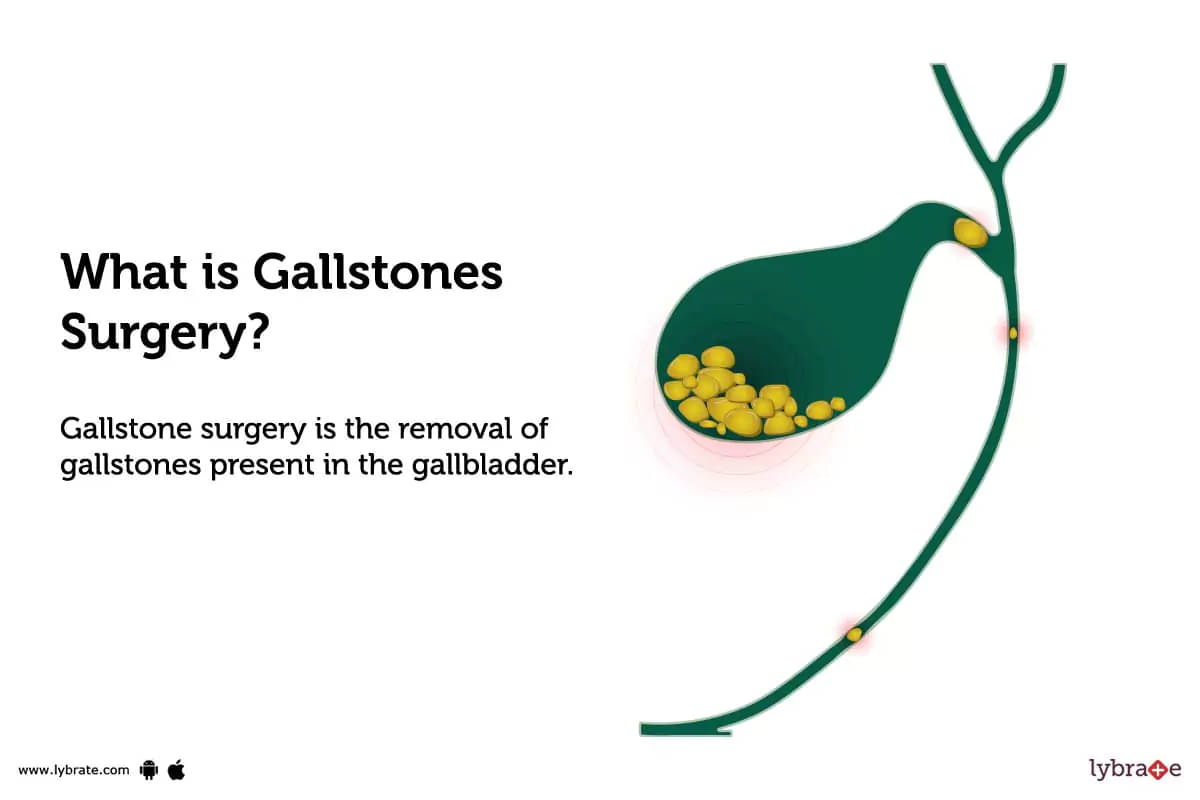Gallstones Surgery: Purpose, Procedure, Benefits and Side Effects
Last Updated: Jun 30, 2023
Overview
Gallstone surgery is the removal of gallstones present in the gallbladder. Various gallbladder problems that are evident and symptomatic are commonly treated with cholecystectomy. The gallbladder, a bile-storing pear-shaped organ in the upper right side of the belly, is removed during gallbladder surgery.
Gallstone surgery helps in the treatment of gallbladder-related disorders and inflammation brought on by gallstones. It can be performed in two ways: open surgery and laparoscopic method.
Summary- A surgical operation called gallstone surgery aids in the treatment of gallstones.
Types of Gallstones Surgery
Laparoscopic/robotic cholecystectomy
Laparoscopic procedures are more frequently carried out by surgeons than open procedures. General anesthetics will be used by the surgeon to make the patient unconscious during the gallbladder laparoscopic surgery.
To improve access to the gallbladder, they will then make three or four incisions and insert ports into those incisions. After removing the gallbladder with the use of a tiny camera, the surgeon will close the wounds with stitches or staples .
In some circumstances, they might assist with the surgery using robotics. These operations resemble other laparoscopic cholecystectomies a great deal. The surgeon will control the robot to carry out the procedure, which is the sole difference.
During the treatment, gallstones that are obstructing one or more bile ducts may need to be removed. To see any further stones, they might need to use an X-ray machine.
Open gallstone surgery
In case the laparoscopic procedure does not go well, a surgeon may do an open cholecystectomy. Additionally, they might decide to operate if the gallbladder is: severely inflamed, badly infected or scarred from several other procedures.
Some other reasons a surgeon may switch to an open procedure include:
Summary- Laparoscopic cholecystectomy and open surgery are the two procedures available for treating gallstones.
Benefits of Gallstones Surgery:
- A bile duct obstruction is a common cause of gallbladder inflammation.
- Inflammation caused by digestive fluid that cannot exit the gallbladder can result in significant and occasionally fatal complications, including gallbladder rupture.
- Gallstones are the most common cause of gallbladder inflammation, and cholecystitis affects 1-3% of those who have this illness.
- Laser surgery for gallstones removes the stones and prevents the inflammation.
- Sudden, excruciating pain is one of the main signs of gallbladder illness, especially if gallstones are present.
- Gallstones that are stuck in a bile duct on their way to the stomach frequently cause gallbladder attacks by obstructing bile flow and inducing gallbladder spasms.
- This discomfort can be excruciating and feel like a knife cut. It might even be mistaken for a heart attack in rare circumstances.
- Nothing can prevent a gallbladder attack until the gallstone passes, which could take several hours or days after it starts.
- However, the gallbladder can be surgically removed to end the pain and avoid recurrence.
Summary- Gallstone surgery helps to treat persistent pain and discomfort brought on by gallstones.
Why is Gallstone Surgery done?
Gallstone surgery helps in the treatment of gallstones and their complications.
A doctor might suggest gallstone surgery for the following reasons:
- Gallbladder inflammation
- Pancreas inflammation
- Gallstones in the gallbladder
- Choledocholithiasis
- Gallbladder polyps
Summary- Gallstone surgery is done for the treatment of gallstones and to reduce inflammation caused by it.
Gallstone Surgery: Procedure
Based on your condition, gallstone surgery can be done in the following two ways:
- Open Cholecystectomy: A 5 to 6-inch abdominal incision is made during an open cholecystectomy, after which the muscles and tissue are pulled aside to reveal the liver and gallbladder. The gallbladder is taken out, and the wound is stitched up..
- Laparoscopic Cholecystectomy: Your abdomen will be cut in four places during this surgery, and a tube containing a tiny camera will be implanted. Following that, the incisions are used to implant the surgical instruments and remove the gallbladder.
Summary- During the Gallstone surgery, the doctor makes some incisions in your abdomen and removes the gallbladder.
What are the risks of Gallstone Surgery?
Most operations have certain potential dangers and side effects. Some risks involved in gallstone surgery are:
- Bleeding
- Bile leakage
- Infection
- Blood clot
- Retention of gallstones in the bile duct
- Injury
- Formation of abscess
Summary- The risks of gallstone surgery are: bleeding, infection, blood clot and injury.
How do I prepare for Gallstone surgery?
You'll receive detailed instructions from your healthcare practitioner on how to get ready for gallstone surgery. Here are some general guidelines:
- Wear loose clothes on the day of the procedure
- Avoid eating and drinking before your surgery.
- Take a proper bath before the surgery
- Ask your doctor if you need to stop using any prescription drugs, such as blood thinners.
- The majority of laparoscopies are outpatient operations so bring a few personal belongings with you.
Summary- You should stop taking any medications and food items and wear loose clothes before the surgery.
How much does gallstone surgery cost?
The price of gallstone surgery can range from Rs. 45,000 to Rs. 55,000.
Laparoscopic Gallstone Surgery Cost
Laparoscopic Gallstone removal surgery cost varies depending on the city in which you wish to have it done. Other important considerations like the doctor and facility also come into play.
Therefore, the range of 45,000 to 90,000 rupees is the estimated total cost of the gallstone removal surgery, within which the majority of the city's expenses may be paid.
What to do after gallstone surgery?
After this kind of operation, ice packs aid in reducing swelling and irritation. To lessen the pain and to reduce the swelling in your abdomen, apply some ice packs. Don't put ice on your skin; instead, follow your doctor's recommendations on how long to use the ice pack.
Summary- You should take a nutritious diet and take proper care of the incision areas after the surgery.
What to eat after gallstone surgery?
After the procedure to remove the gallstones, you must consume a healthy, balanced diet. Eat the following foods as part of your diet:
- Raw nuts
- Fruits and vegetables
- Fibre-rich foods
- Beans
- White rice
- Bananas
- Boiled potatoes
- Dry toast
- Crackers
- Lentils
- Plain pasta
- Peas
- Oats
- Whole grain
- Barley
Summary- You should take a diet rich in fibre and vitamins after the gallstone surgery.
Is gallstone surgery safe?
Although there are some potential hazards and side effects, gallbladder ectomy is a reasonably common and safe treatment. The best defense against gallstone attacks is surgery. Due to the surgery's high frequency, surgeons have a lot of experience doing it.
Without a gallbladder, your body will function perfectly. You might not notice any noticeable changes in the way you digest food, although there might be slight ones.
Is gallstone surgery painful?
After the surgery, you'll feel pain, but it can be controlled with the right medication. Naturally, your initial recovery period will be more painful than subsequent ones, but this will pass as your body heals.
The discomfort associated with gallbladder removal is similar to that of other procedures. Ice is a suitable addition to painkillers after gallbladder surgery. Your incisions may feel less painful if you apply ice to them.
You prevent frostbite on your skin, make sure to only apply ice for a 20-minute period at a time.
How long does it take to recover from Gallstone surgery ?
Gallstone removal surgery recovery period isn't too long. The patient might need to spend one or two nights in the hospital after having a cholecystectomy, or they might be released from the recovery room after almost six hours.
In this situation, you will need a relative or friend to drive you home, where you can finish healing. If you have gallstone open surgery, you will be brought to a hospital room and kept there for two to four days.
The Gallstone surgery scars are also not that prominent and fade with the passage of time.
Summary- After gallstone surgery, recovery could take approximately a week.
What are the side effects of Gallstones surgery?
The following adverse effects are possible following gallstones surgery:
- Diarrhoea
- Constipation
- Injury
- Fever
- Bile leakage
- Infection
- Bleeding
- Deep vein thrombosis
- Bowel problems
Summary- The side effects of gallstone surgery are: diarrhoea, bleeding, infection, fever and bile leakage.
Gall stone surgery Aftercare
Aftercare instructions for gallstone surgery are:
- Take care of the wounds.
- Take proper rest for faster recovery
- Take food items rich in fibre.
- Wear loose clothes.
- Do not involve yourself in strenuous activities.
- Avoid driving.
- Do not lift heavy objects
- Keep the incision area clean
Summary- Post-treatment guidelines for gallstone surgery are: take a healthy diet, clean your wounds properly and avoid any strenuous activity.
Conclusion
Gallstones are frequently a chronic condition accompanied by lots of pain and discomfort, therefore it's crucial to undergo a surgical procedure if no medications are working for you. The surgical removal of the gallstone is known as gallstone surgery. Although it is a safe operation, there are some potential dangers and problems. It can be performed in two ways: laparoscopic cholecystectomy and open cholecystectomy.
Table of content
15+ Years of Surgical Experience
All Insurances Accepted
EMI Facility Available at 0% Rate
Find General Surgeon near me
Ask a free question
Get FREE multiple opinions from Doctors



